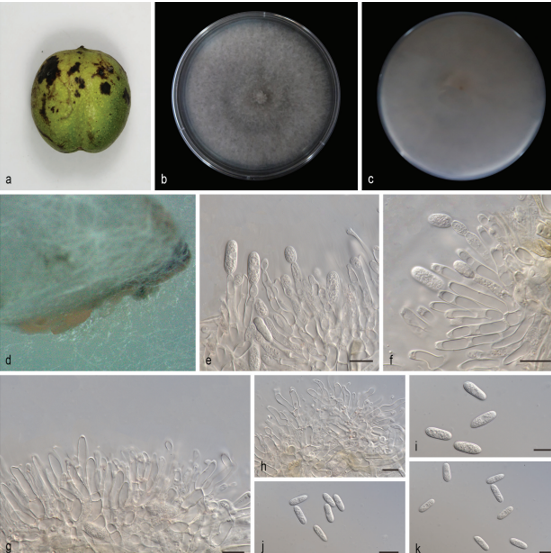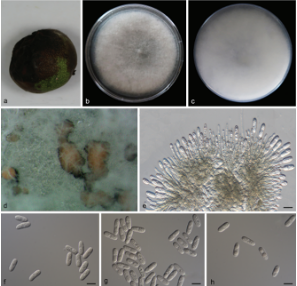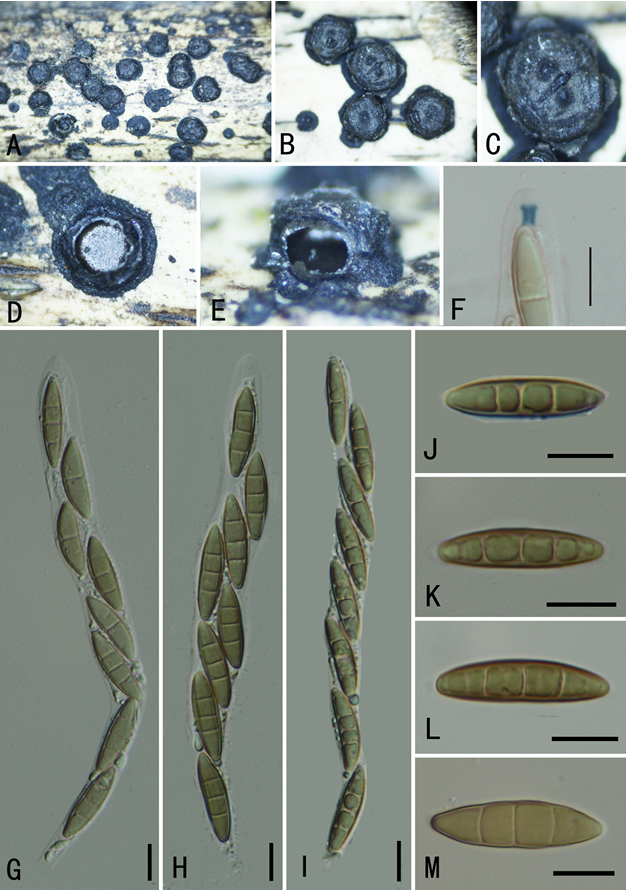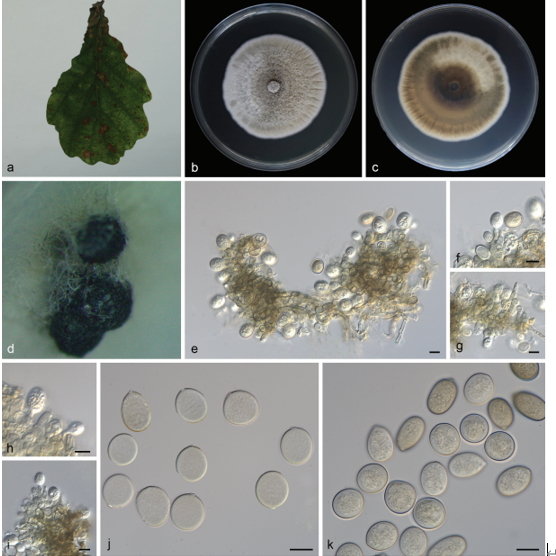Ophiostoma xinganense Z. Wang & Q. Lu 2020
MycoBank MB 830617
Holotype: China: Inner Mongolia Autonomous Region, Genhe, from Ips subelongatus infesting Larix gmelinii, Sept. 2017, Q. Lu (CXY 2005 – holotype, CFCC 52679 – ex-type culture).
Morphological description
Sexual morph not observed. Asexual morphs: pesotum-like, sporothrix-like and hyalorhinocladiella-like. Pesotum-like morph: synnemata solitary or in groups, base black, (16.5–) 29.5–80 (− 114.5) μm wide, (446–) 483–768 (− 953) μm tall including the conidiogenous apparatus. Conidiogenous cells (11–) 13–23.5 (− 29.5) × (1–) 1.5–2 μm. Conidia hyaline, smooth, ovate to oblong, aseptate, 3.5–4.5 (− 5) × 2–2.5 μm. Sporothrixlike morph: conidiogenous cells arising directly from hyphae, (15.5–) 21.5–49.5 (− 79) × 1.5–2 (− 2.5) μm. Conidia hyaline, smooth, ovate to oblong, aseptate, 4–5.5 (− 7) × (2–) 2.5–4 (− 4.5) μm. Hyalorhinocladiella-like morph: conidiogenous cells arising directly from hyphae, (9.5–) 11–18.5 (− 23) × 1.5–2 (− 2.5) μm. Conidia hyaline, smooth, ovate to oblong, aseptate, (4–) 4.5–5 (− 5.5) × 3–4 μm. Cultures: Colonies on 2% MEA at 25 °C reaching 75mm diam. in 10 d, initially whitish gray, the colonies edge thinning radially; hyphae mostly superficial, sparsely aerial, synnemata developing abundantly in the colonies centre. Optimal temperature for growth at 25 °C, no growth observed at 5 °C and 40 °C.
Habitat: L. gmelinii pure plantation.
Ecology: Isolated from Ips subelongatus infesting dying Larix gmelinii and stock log.
Distribution: Inner Mongolia Autonomous Region, China.
GenBank Accession: ITS/LSU MK748186; β-tubulin gene MN896056; EF-1α MN896078; calmodulin gene MN896097
Notes: Ophiostoma xinganense is closely related to O. rufum. Ophiostoma xinganense develops three synanamorphs, pesotum-like, sporothrix-like and hyalorhinocladiella-like asexual states, but O. rufum has pesotum-like and sporothrix-like states and lacks hyalorhinocladiella-like state (Jankowiak et al. 2019). Both sporothrix-like and pesotum-like asexual states have been observed in both species, but their conidia are different in shape and size. Conidia of sporothrix-like asexual state is ovate to oblong shape with 4–5.5 (− 7) × (2–) 2.5–4 (− 4.5) μm in O. xinganense vs. clavate or fusiform (primary conidia) with (7.2–) 8.9–12.4 (− 15.2) × (2–) 2.5–3.1 (− 3.4) μm in O. rufum, showing the former much smaller and rounder compared to the latter. Conidia of pesotum-like asexual state is ovate to oblong shape with 3.5–4.5 (− 5) × 2–2.5 μm in O. xinganense vs. oblong to curved shape with (2.5–) 3.3– 4.5 (− 6.2) × (1.2–) 1.4–1.7 (− 2.2) μm in O. rufum, showing the former wider and rounder than the latter.
Reference: Wang Z, Liu Y, Wang HM et al. (2020) Ophiostomatoid fungi associated with Ips subelongatus, including eight new species from northeastern China
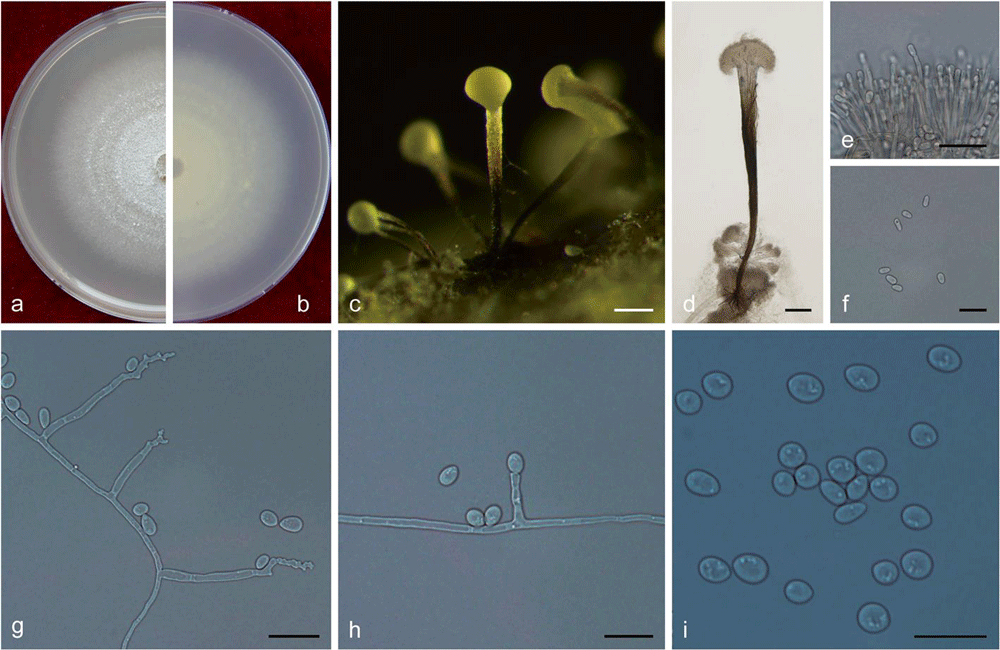
Ophiostoma xinganense. Morphological characteristics of O. xinganense (CFCC 52679). a–b. Ten-day-old culture on 2% MEA; c–d. Pesotum-like asexual morph; e–f. Conidiogenous cells of pesotum-like asexual morph and conidia; g. Sporothrix-like asexual morph: conidiogenous cells and conidia. h–i. Hyalorhinocladiella-like asexual morph: conidiogenous cells and conidia. Scale bars: c = 100 μm; d = 50 μm; e–i = 10 μm


